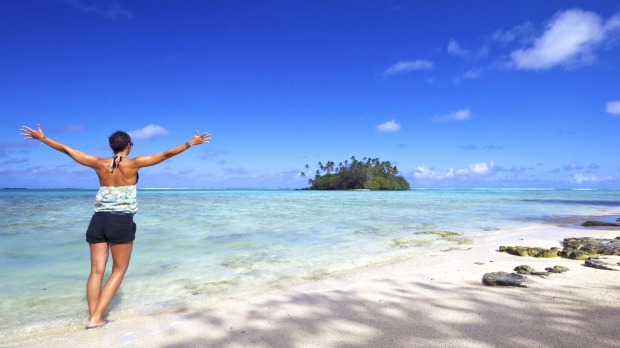
We've only been in the Cook Islands a few days when I start to feel an overwhelming urge to pack up and move here. Forever. The sentiment arrives somewhere between swimming around the Ta'akoka Motu, home to schools of butterfly fish and enormous trevally, and watching my six-year old daughter shimmy barefoot along a coconut palm bent low over the long, white sweep of Muri Beach.
Partly, I think it's the Huckleberry Finn lifestyle that children enjoy on the island – no shoes (the local kids go barefoot to school) and a life that revolves around the outdoors, thanks to the glorious year-round weather. There are also the astonishingly beautiful lagoons, a heart-stopping shade of blue the colour of the iconic Tiffany box, offset by beaches with sand almost as white as the ribbons that tie it.
When I stumble upon a tumbledown shack, perched on stilts in the sand mere steps from the water, and seemingly abandoned, I romantically envisage a life where my family lives here for at least a few months of the year – preferably during Australia's winter. Or we could just come on annual holidays.
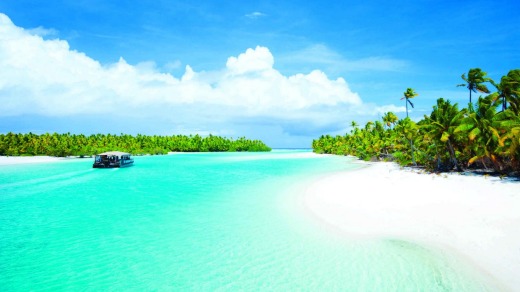
I was a little anxious, being the Fiji-ophiles we are (a destination we return to over and over), that perhaps my family wouldn't fall for the Cooks in the same way. But as we round the island, doing the 32-kilometre circuit by school bus, my husband admits he likes it just as much, perhaps even more. He doesn't even scoff when I look up local real estate on the internet; a sure sign he shares my affection for this wonderful South Pacific destination.
Ideally, you need at least a week to fall into the rhythm of these undeveloped and low-key islands. Luckily, that fits in well with the Air New Zealand flight schedule from Sydney, which departs and returns on a Saturday. By the time you've uttered your first "Kia orana" and kicked off your shoes, you're well on your way to slipping into island time.
We arrive just after sunrise, flying low over the aquamarine sea, framed by swaying palms. As we are processed by immigration, a man wearing a straw hat welcomes visitors with the happy sound of the ukulele; the overwhelming smell of the ei kaki flower garlands assaults the senses – letting you well and truly know you've landed in utopia.
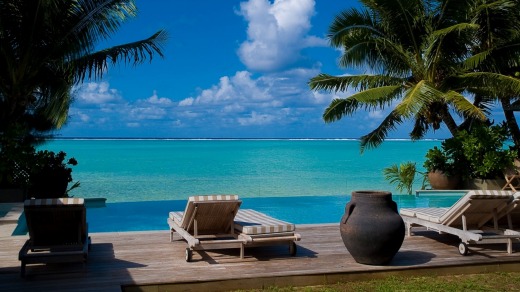
From our base at the new luxe family Nautilus Resort, our days are long and languorous, with nowhere in particular to be at any particular time. We take long walks on the beach, collecting seashells, hunting for hermit crabs and exploring shallow rock pools. We hold hands as we snorkel the Muri Lagoon. My daughter, Ella, rips off her goggles and yells in triumph as she spots an electric-blue needlefish on her first snorkelling expedition.
We kayak around the volcanic motu just offshore; have coffee at Le Bon Vivant (LBV), a French-inspired bakery with incredible pastries and jam donuts; take strolls with the friendly island dogs; and swim in the sandy-bottomed lagoon, scattered with sea cucumbers.
It's the tail end of whale-watching season when we are there in October, but nonetheless we spot two humpbacks just beyond the reef. Later, on a dive with Big Fish Dive Centre to Edna's Anchor, we clearly hear them calling to each other.
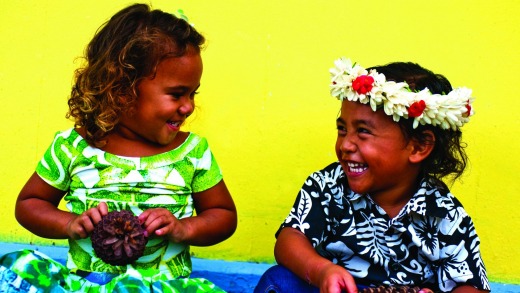
The majority of Cook Islanders are of Polynesian descent and speak Cook Island Maori. They exude warmth, happiness and generosity, stopping to chat with you as you walk along the street. Nonetheless, one ample-sized lady, wearing a pandanus straw hat in a weave unique to the Cooks, has fixed her gaze on me one morning at the bakery. She eyeballs me every time I walk past and I feel slightly disconcerted until she corners me, a huge smile breaking over her face. "Where did you get your dress?" she gushes. Relieved, we swap notes on clothing and she tells me the best place to buy the traditional broad-brimmed hat she and other islanders wear is the Panunga Nui markets.
The great thing about the main (and largest) island of Rarotonga – a captivating mix of rugged mountains, dense jungle and beaches – is it is like one big, happy resort. This means it's easy to get around the island by scooter, the island bus service or by renting a car (although these can be pretty rugged; our front axle sounded like it was going to fall off at any moment). If you stay at the main resort area of Muri Beach, you can walk to nearly everything.
More than 50 cafes and restaurants offer everything from fish and chips by the sea to fresh Asian-style meals at Rickshaw in a pretty garden setting, or the ultimate in fine dining at Tamarind House. The night markets at Muri Beach (Sunday, Tuesday, Wednesday and Thursday from 5.30pm) are terrific for delicious and affordable local food, including ika mata (raw fish salad), poke (made with local fruit and cassava/tapioca) and pawpaw and mango salad.
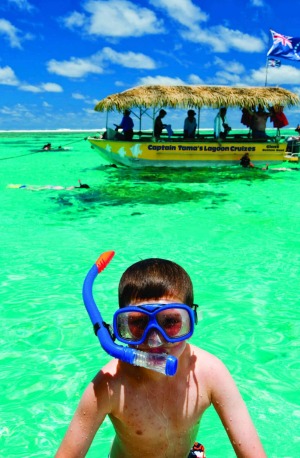
Normally I avoid cultural shows, finding them cringe-worthy, but Highland Paradise is special. Even the bus ride there is an adventure, with the driver turning off the air-conditioning for the steep climb to the lush interior, with its views to the lagoon below. The dinner and dance show starts with a ceremonial welcome and includes an excellent buffet dinner of traditional meats and vegetables cooked in an underground oven (umu), along with salads, tropical fruit and dessert. The energetic dances, which trace the evolution of Rarotonga culture through to the island's conversion to Christianity, are performed by dancers and guides who are descendants of Ariki (high chief) Tinomana. The atmosphere is electric, with the enthralling beat of the drums, the colour and movement of the beautiful dancers, and I feel like we've learned something.
Maori legend has it that that they came to New Zealand aboard seven ocean-going canoes, called vaka, which left from Rarotonga. I walk to the Avana Harbour foreshore site, which looks out over the azure sea. I stand there trying to imagine the Maoris setting off on the last leg of their arduous journey. I can't fathom why they left. After I'm home the yearning to return is so intense, I continue to look at real estate ads. Once you've found paradise, it's hard to let go.
Visit the legendary Aitutaki, where tiny offshore islets known as motu appear like beads strung along the protective coral reef; the white beaches that border each island are equally beautiful. The day includes an island tour by "le truck", followed by a cruise aboard the 21-metre vaka (catamaran) Titi-ai-Tonga with snorkelling and a barbecue lunch cooked on board. The tour operates daily Monday to Saturday from Rarotonga, departing at 8am and returning by 5.30pm. See airraro.com or thevakacruise.com.
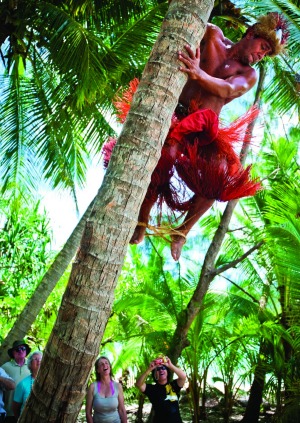
Join the blonde, dreadlocked Pa on a guided walking and hiking tour into Rarotonga's lush interior. Learn how the island's Polynesian ancestors lived and treated sickness with ancient herbal remedies, and hear Pa's tales of war and migration passed down by his forefathers. The three-hour track passes through Noni plantations and paddy fields, crossing streams into the jungle. See pastreks.com
Children as young as eight can dive in the Cook Islands, and it's the ideal place to learn in sheltered, gentle and clear lagoons brimming with tropical fish, diverse corals and giant turtles. Shallow lagoon dives are offered in the beautiful Marine Reserve of Aroa Beach, just opposite the Big Fish Dive Centre for beginners, meaning kids can learn in the sea rather than a pool. See thedivecentre-rarotonga.com
Swim at Papua (Wigmore's) Waterfall. Hike or drive up to the waterfall, which you can stand under, and see if you can find the shy freshwater prawns in the natural rock pool.
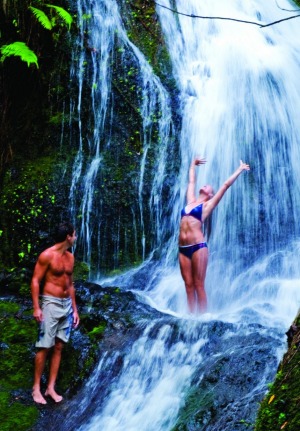
Join Koka Lagoon Cruises' glass-bottom boat cruise of Muri Lagoon, watch the fish being fed and snorkel off the boat before stopping at a deserted island (motu) for a beach barbecue lunch. On the other side of the motu, there's an old shipwreck. The fun day involves ukuleles and singing. See kokalagooncruises.com.
sale.cookislands.travel
Air New Zealand flies direct from Sydney to Rarotonga each Saturday (flights connect through Auckland on other days). Phone 13 24 76, see airnewzealand.com.au.
One-bedroom are (villas) at the new, family-friendly 4.5-star Nautilus Resort on Muri Beach, Rarotonga, start from $587 per night, up to $1713 a night for the premium beachfront, three-bedroom re. Opening specials (building works continue on the first 17 villas), including stay 10 nights pay seven, are on offer until April 30. See nautilusresortrarotonga.com.au
The six private villas in the Te Vakaroa Villas property, also on Muri Beach, priced from $778 per night, offer beachside chic for families with older children (12 and over), with views of the lagoon across the infinity pool. See tevakaroavillas.com.
The writer was a guest of Nautilus Resort and Te Vakaroa Villas.